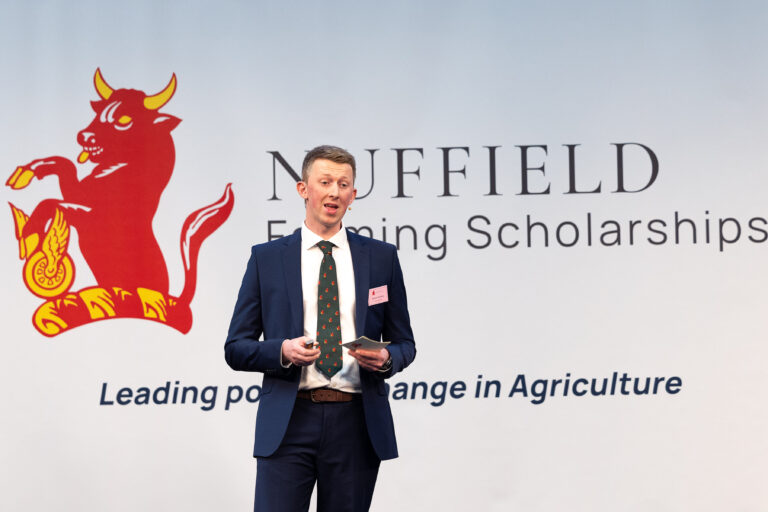Scottish farm operations manager Alistair McBain has published his Nuffield Farming report ‘From Beans to Bugs – Alternative Proteins to Drive Net Zero Egg Production’, sponsored by The MacRobert Trust.
During his Scholarship, Alistair travelled to Canada, the USA, Brazil, Argentina, the United Kingdom, Sweden, the Netherlands, and Germany.
“Soya in laying hen diets accounts for around 60% of the total carbon footprint (CFP) of an egg, so reducing or removing soya from diets will have a significant effect on reducing carbon emissions,” the report states.
During his scholarship, McBain reviewed alternative protein sources to drive egg production towards net zero emissions.
McBain noted that grain legumes, particularly faba beans, are of interest in the UK as a home-grown source of protein, with recent breeding advancements in breeding creating low vicine varieties. “Anti-nutritional compounds have limited the use of faba bean in laying diets up until now due to effects on performance and mortality. Further investment is needed to breed varieties with increased yields of protein, disease resistance and early maturity.”
He also explored the use of industry by-products, including DDGS from bioethanol production and processed animal proteins: “One of the main problems with the use of by-products is their variability in nutritional value. Constant monitoring is required to correctly formulate diets to meet the nutritional requirements of laying hens.
“Novel protein sources such as insect protein fed on low-grade food waste, and single-cell proteins grown on captured CO2 from industrial processes have great potential in providing protein sources with a negative carbon footprint, vital for offsetting unavoidable emissions on the road to net zero.”
Processed animal proteins
McBain’s report also examines the use of processed animal proteins (PAP), also known as meat and bone meal, which have been banned in the UK since 1988. PAP is derived from rendering animal by-products not intended for human consumption.
PAP is, however, used widely in the US. Regulation change in the EU in 2021 allows the use of PAP under strict rules. PAP from pigs can be fed to poultry and PAP from poultry can be fed to pigs in the EU. No ruminant PAP can be used because of concerns about BSE.
Feed mills using PAP in Europe must be single species mills to avoid the risk of cross contamination between the two PAP species. It is expected that legislation mirroring the EU legislation will be introduced in the UK in 2025.
In the US McBain visited Kristjan Bregendahl, a poultry nutritionist working for Devenish, feeding more than 50 million laying birds across the US from small Amish producers to large scale companies with more than 10 million layers.
He explained that like DDGS, the nutritional analysis of PAP can vary significantly, so constant monitoring must be carried out. He mentioned that occasionally, when demand for leather is low, abattoirs include the hides of animals in PAP which can cause issues with poultry as they are unable to digest the hairs.
The limiting factor to using PAP is the level of phosphorus. The ratio of calcium to phosphorus required during the growing phase of poultry is 2:1.
One of the perceived challenges of using PAP in the UK is public perception around food safety, along with transparency and ethical concerns. Although none of these concerns have been a huge barrier to its use in Europe, they will all need to be considered by the UK industry.
McBain concluded that currently none of the alternative protein sources studied are a complete replacement for soya: “A combination of alternative protein sources is required to significantly reduce or replace soya completely, resulting in an increase in the cost of the diet.
“Support is required to cover the cost of using alternative proteins either through investment in finding solutions to reduce the cost of production of the alternatives, i.e. plant breeding or scaling insect protein production, or increasing the price paid to egg producers, potentially through differentiated egg brands.”
Alistair McBain’s report. The main findings:
- Soya in layer diets currently contributes to around 60% of the carbon footprint of an egg. Using alternative proteins has the potential to significantly reduce the carbon footprint.
- No single alternative protein source can be considered a direct replacement for soya. A combination of protein sources and in many cases the addition of synthetic amino acids are required to produce a diet with the correct nutritional profile.
- Constant analysis is required to assess the variability in the nutritional quality of many alternatives, particularly industry by-products.
- Development in novel protein sources such as insect protein and single-cell proteins have the most potential for reducing the carbon footprint.


